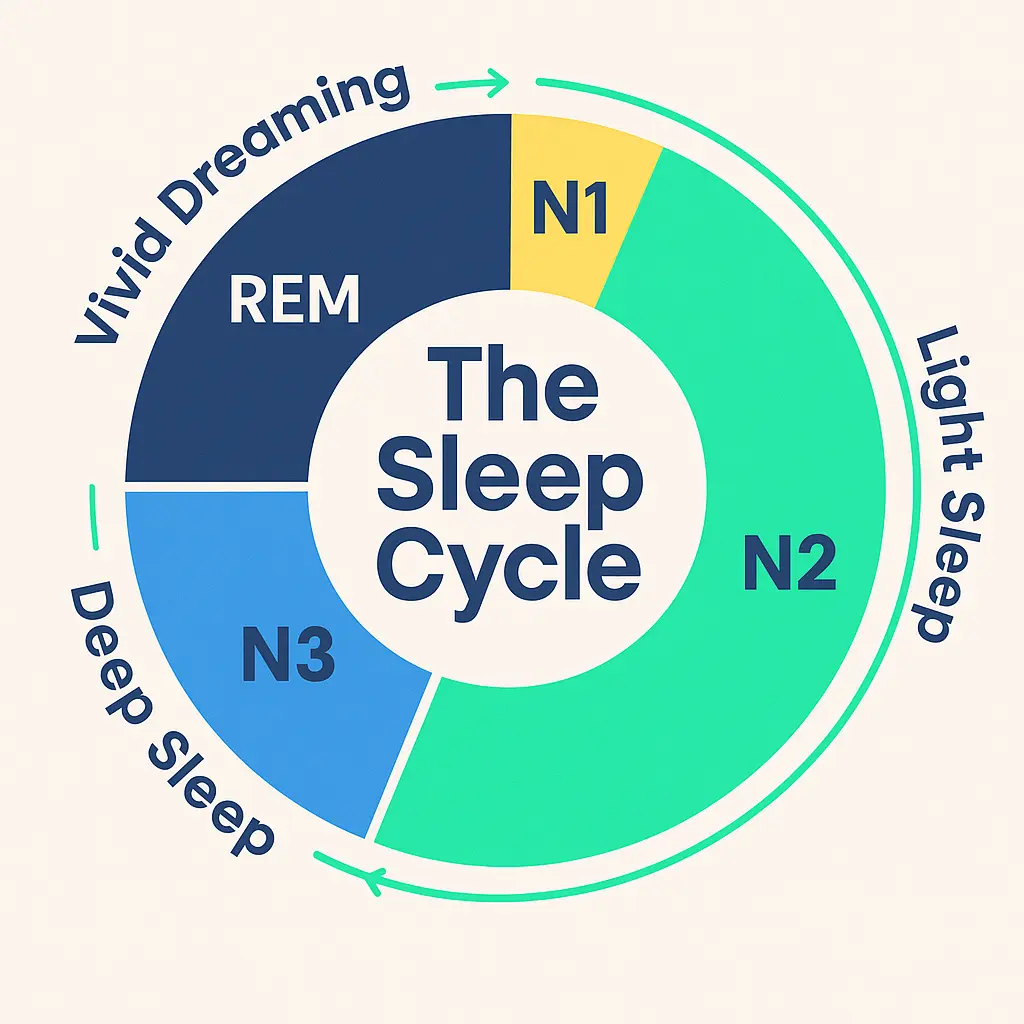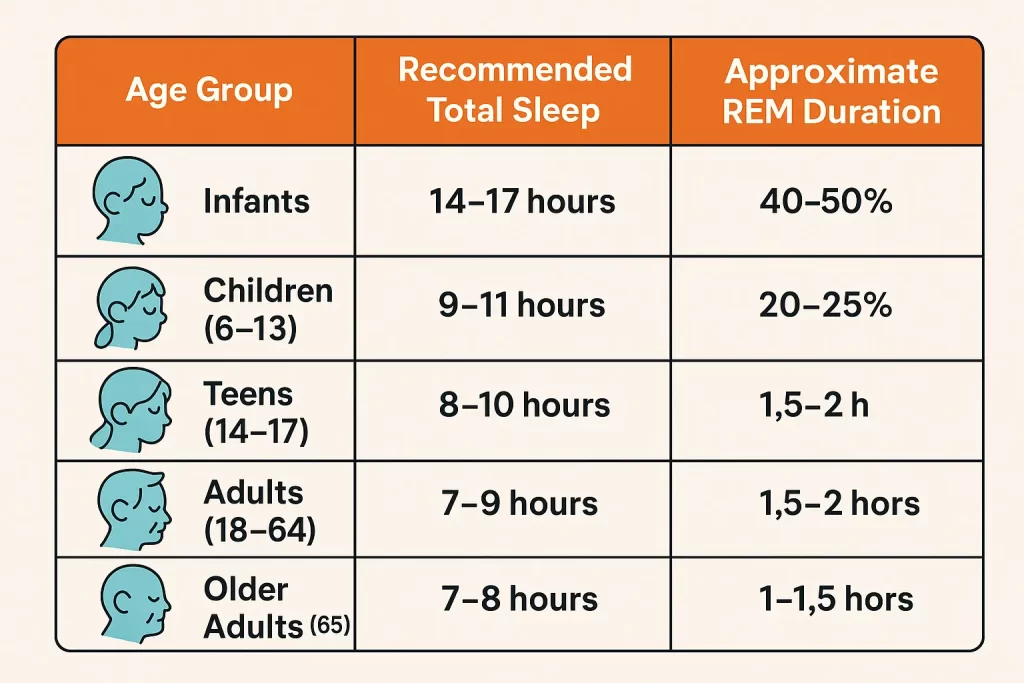Sleep is one of the most essential functions our body needs to survive and thrive. We spend about one-third of our lives sleeping, yet many people don’t fully understand what happens when we close our eyes at night. Sleep is not just about rest—it’s about recovery, processing, and renewal.
Sleep is divided into different stages, and each one plays a unique role in maintaining your physical and mental health. Among them, REM sleep (short for Rapid Eye Movement sleep) is perhaps the most fascinating and critical. This stage is linked to vivid dreams, emotional health, memory retention, and brain development.
But what exactly is REM sleep? Why does it matter so much? And how can you make sure you’re getting enough of it? Let’s explore.
Contents
- 1 What Is REM Sleep?
- 2 The Sleep Cycle: Understanding All Four Stages
- 3 What Happens During REM Sleep?
- 4 Why Is REM Sleep Important?
- 5 How Much REM Sleep Do You Need?
- 6 Signs You’re Not Getting Enough REM Sleep
- 7 What Disrupts REM Sleep?
- 8 How to Improve REM Sleep Naturally
- 9 Conclusion: Your Brain Needs REM Sleep to Thrive
- 10 Frequently Asked Questions (FAQs)
What Is REM Sleep?
REM sleep is one of the four stages of the sleep cycle. It gets its name because of the rapid, side-to-side eye movements that occur beneath your closed eyelids. While your eyes are active, the rest of your body becomes temporarily paralyzed. This stage is unique because your brain activity increases, almost mimicking the alertness of being awake.
Key Features of REM Sleep:
- Rapid eye movements
- Increased brain activity
- Vivid, emotional dreams
- Temporary muscle paralysis
- Irregular breathing and faster heart rate
The first REM stage typically begins 90 minutes after falling asleep and lasts around 10 minutes. With each sleep cycle throughout the night, REM stages become longer, lasting up to one hour by morning. Adults typically spend 20–25% of their total sleep in REM.
The Sleep Cycle: Understanding All Four Stages

Sleep isn’t just REM and non-REM. It’s a cyclical pattern made up of four stages that repeat several times during the night:
1. Stage 1 (Light Sleep)
- Transition phase between wakefulness and sleep
- Lasts a few minutes
- Muscle activity slows down
- You can wake up easily
2. Stage 2 (Onset of Real Sleep)
- Body temperature drops
- Heart rate slows
- Eye movement stops
- Sleep spindles (short bursts of brain activity) begin
- Makes up 50% of total sleep
3. Stage 3 (Deep Sleep or Slow-Wave Sleep)
- Also known as N3
- Hardest to wake from
- Critical for physical healing and immune function
- Muscles and tissues repair
- Blood pressure drops
4. Stage 4 (REM Sleep)
- Brain activity increases
- Dreaming intensifies
- Muscles are temporarily paralyzed
- Memory and emotional processing occur
These stages cycle approximately every 90 minutes, with 4–6 full cycles occurring during a full night’s rest.
What Happens During REM Sleep?
Although your body appears deeply at rest during REM sleep, your brain is highly active, sometimes even more so than during wakefulness. Here’s what happens:
Brain Activity
Your brain waves become faster and more irregular, similar to when you’re awake. This is why dreams during REM sleep are so vivid.
Dreaming
Most of our intense and emotional dreams occur during REM sleep. These dreams may reflect your thoughts, worries, desires, or creative ideas.
Memory Processing
The brain uses this time to process experiences, store memories, and make connections. This plays a key role in learning and emotional health.
Muscle Paralysis
To keep you from acting out your dreams, your body goes into temporary paralysis (also known as REM atonia). This is a safety feature controlled by the brainstem.
Autonomic Changes
- Breathing becomes irregular
- Heart rate and blood pressure increase
- Body temperature may fluctuate
These physical and mental shifts are what make REM sleep so unique and vital to our well-being.
Why Is REM Sleep Important?
1. Improves Memory and Learning
REM sleep is essential for forming long-term memories. It helps the brain absorb new information and connect it with what you already know. This is why students who sleep well tend to perform better.
2. Supports Emotional Health
During REM sleep, the brain processes emotional experiences. It helps regulate your mood and reduces emotional reactivity. Studies show a lack of REM sleep may contribute to anxiety, irritability, and depression.
3. Boosts Brain Development
In infants and young children, REM sleep takes up to 50% of total sleep time. This is because it’s critical for brain development, learning language, and forming early memories.
4. Enhances Creativity and Problem-Solving
REM sleep helps organize thoughts, spot patterns, and generate creative ideas. Ever woken up with the answer to a problem? That’s REM sleep at work!
5. Helps Process Trauma
People recovering from emotional trauma or PTSD may experience disrupted REM sleep. Over time, healthy REM sleep can help people process difficult memories more safely and peacefully.
Also Read: Can I Take Zopiclone and Promethazine? A Comprehensive Guide to Risks, Safety, and Alternatives
How Much REM Sleep Do You Need?

The amount of REM sleep you need depends on your age and overall health:
| Age Group | Recommended Total Sleep | REM Sleep % | Approximate REM Duration |
|---|---|---|---|
| Infants | 14–17 hours | 40–50% | 7–8 hours |
| Children (6–13) | 9–11 hours | 20–25% | 2 hours+ |
| Teens (14–17) | 8–10 hours | 20–25% | 1.5–2 hours |
| Adults (18–64) | 7–9 hours | 20–25% | 1.5–2 hours |
| Older Adults (65+) | 7–8 hours | ~20% | 1–1.5 hours |
If you’re not getting enough total sleep, your body may prioritize REM sleep, cutting down other stages. However, chronic sleep deprivation eventually reduces REM quality, impacting mental function.
Signs You’re Not Getting Enough REM Sleep
Lack of REM sleep may not be obvious at first, but over time, you may notice:
- Trouble concentrating or remembering things
- Mood swings or increased stress
- Poor decision-making or creativity
- Fatigue, even after a full night’s sleep
- Increased cravings and poor appetite control
- Lower immune function
- Difficulty learning new skills
Chronic REM sleep deprivation has been linked to conditions such as depression, obesity, Alzheimer’s, and cardiovascular disease.
What Disrupts REM Sleep?
Even if you sleep for 7–8 hours, your REM cycles can still be interrupted. Common culprits include:
1. Stress & Anxiety
Racing thoughts or overthinking can prevent your brain from fully relaxing, disrupting REM cycles.
2. Alcohol & Substance Use
While alcohol may help you fall asleep faster, it actually suppresses REM sleep, especially in the early part of the night.
3. Medications
Some antidepressants, beta-blockers, and sleep aids can reduce REM sleep or delay its onset.
4. Sleep Disorders
Conditions like sleep apnea, restless leg syndrome, or insomnia can prevent the brain from cycling properly through REM stages.
5. Irregular Sleep Schedule
Shift workers or those who stay up late and wake early often disrupt their circadian rhythm, reducing the body’s natural REM cycles.
6. Poor Sleep Environment
Noisy, bright, or uncomfortable bedrooms can cause micro-awakenings that interfere with REM transitions.
How to Improve REM Sleep Naturally
Getting better REM sleep doesn’t always require medication. Here are science-backed tips to naturally boost REM sleep quality:
1. Stick to a Regular Sleep Schedule
Go to bed and wake up at the same time every day—even on weekends.
2. Limit Alcohol and Caffeine
Avoid alcohol and caffeine at least 4–6 hours before bedtime.
3. Reduce Screen Time
Blue light from phones and computers can delay melatonin release, the hormone that signals sleep. Try reading a book instead.
4. Create a Sleep-Friendly Environment
- Keep your room cool (65–70°F or 18–21°C)
- Use blackout curtains or a sleep mask
- Eliminate noise or use white noise machines
5. Exercise Regularly
30 minutes of moderate exercise most days of the week can help promote better sleep cycles, including REM.
6. Try Relaxation Techniques
Breathing exercises, meditation, and even warm baths can calm your nervous system and improve sleep depth.
7. Seek Help for Underlying Conditions
If you suspect you have sleep apnea or another disorder, consult a sleep specialist. Treating these conditions can significantly improve REM sleep quality.
Conclusion: Your Brain Needs REM Sleep to Thrive
REM sleep isn’t just a time for dreams—it’s when your brain organizes memories, processes emotions, and refreshes your mind. It’s a powerful and essential part of your sleep cycle that directly impacts how you feel, think, and function every day.
If you’re not getting enough REM sleep, you might feel sluggish, forgetful, or emotionally drained—often without knowing why. By improving your sleep hygiene and becoming more aware of how your habits affect your sleep, you can take back control of your nights and your health.
Frequently Asked Questions (FAQs)
Q1: Can you dream outside of REM sleep?
Yes, but dreams during non-REM sleep are usually less vivid and less emotional than those in REM.
Q2: Is it bad to wake up during REM sleep?
Waking up during REM can leave you feeling groggy or confused. This is called sleep inertia and can affect your alertness.
Q3: Does REM sleep help with physical recovery too?
REM sleep primarily helps with mental and emotional recovery, while deep sleep (Stage 3) plays a larger role in physical healing.
Q4: Can naps include REM sleep?
It depends on how long you nap. REM sleep usually starts around 90 minutes after falling asleep, so short naps (20–30 minutes) usually don’t include REM unless you’re sleep-deprived.
Also Read: Zopiclone 7.5 mg how many can I take?

